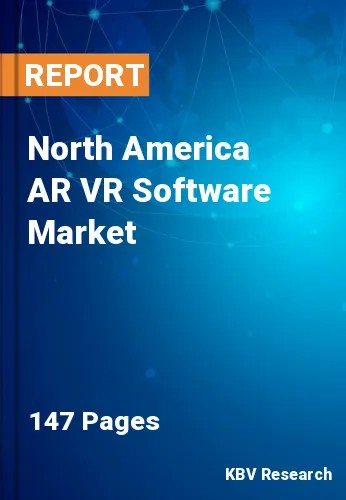The North America AR VR Software Market would witness market growth of 17.4% CAGR during the forecast period (2023-2030).
Companies are investing heavily in creating compelling and high-quality content that showcases the true potential of AR and VR. Game developers, educational institutions, healthcare providers, and enterprises are all contributing to a diverse ecosystem of applications and experiences.
The development of software development kits (SDKs) and platforms tailored to AR and VR development has made it easier for developers to create applications and experiences. These tools provide essential resources for building interactive environments, enhancing object recognition, and integrating spatial tracking. As a result, the market is growing rapidly, with a wide array of applications emerging in various domains. Moreover, partnerships between technology giants, content creators, and hardware manufacturers have fostered innovation in the AR and VR sector. Collaborations have enabled the creation of more integrated and user-friendly ecosystems, driving the adoption of these technologies.
Virtual reality headgear and augmented reality apps are examples of mixed reality technologies that can also aid in the discovery of new planets like the Moon and Mars. NASA scientists have assessed tools and technologies to gain perspective into how they can be utilized to make significant contributions to science by traveling to extreme environments on Earth that are similar to locations on other worlds. In a special edition of Planetary and Space Science, three projects run by scientists at NASA's Ames Research Center in California's Silicon Valley presented their findings. New information on how to research volcanic situations on other planets, mission operating designs to handle doing science in harsh environments, methods to look for life, and other discoveries were included in those results. Therefore, the rapid development and integration of XR technologies across various sectors are mainly responsible for expanding the market in the coming years.
The US market dominated the North America AR VR Software Market by Country in 2022, and would continue to be a dominant market till 2030; thereby, achieving a market value of $20,576 Million by 2030. The Canada market is showcasing a CAGR of 20% during (2023 - 2030). Additionally, The Mexico market would register a CAGR of 19% during (2023 - 2030).
Based on Vertical, the market is segmented into Media & Entertainment, Training & Education, Travel & Hospitality, Manufacturing, Healthcare, Aerospace & Defense, Real Estate, Automotive, Retail & E-commerce, and Others. Based on Technology Type, the market is segmented into AR Software, and VR Software. Based on Software Type, the market is segmented into Software Development Kit, Game Engine, Modeling & Visualization Software, Content Management System, Training & Simulation Software, and Others. Based on countries, the market is segmented into U.S., Mexico, Canada, and Rest of North America.
Free Valuable Insights: The AR VR Software Market is Predict to reach $97.3 Billion by 2030, at a CAGR of 18.1%
The market research report covers the analysis of key stake holders of the market. Key companies profiled in the report include Microsoft Corporation, Google LLC, Magic Leap, Inc., Adobe, Inc., Autodesk, Inc., NVIDIA Corporation, Advanced Micro Devices, Inc., Qualcomm, Inc., Zoho Corporation Pvt. Ltd., and Hexagon AB.
By Vertical
By Technology Type
By Software Type
By Country
Our team of dedicated experts can provide you with attractive expansion opportunities for your business.

